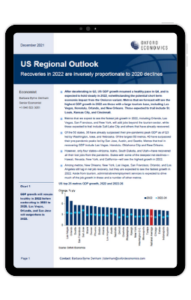United States recoveries in 2022 are inversely proportionate to 2020 declines

After decelerating in Q3, US GDP growth resumed a healthy pace in Q4, and is expected to hold steady in 2022, notwithstanding the potential short term economic impact from the Omicron variant. Metros that we forecast will see the highest GDP growth in 2022 are those with a large tourism base, including Las Vegas, Honolulu, Orlando, and New Orleans. Those expected to trail include St. Louis, Kansas City, and Cincinnati.
What you will learn:
- Metros that we expect to see the fastest job growth in 2022, including Orlando, Las Vegas, San Francisco, and New York, will add jobs beyond the tourism sector, while those expected to trail include Salt Lake City and others that have already recovered.
- Of the 50 states, 36 have already surpassed their pre-pandemic peak GDP as of Q3 led by Washington, Iowa, and Nebraska. Of the largest 50 metros, 40 have surpassed their pre-pandemic peaks led by San Jose, Austin, and Seattle. Metros that trail in recovering GDP include Las Vegas, Honolulu, Oklahoma City and New Orleans.
- However, only four states—Arizona, Idaho, South Dakota, and Utah—have recovered all their lost jobs from the pandemic. States with some of the steepest net declines—Hawaii, Nevada, New York, and California—will see the highest growth in 2022.
Tags:
Related Services

Post
US Rolls Up Welcome Mat for International Travel
Research Briefing United States recoveries in 2022 are inversely proportionate to 2020 declines Trump tariffs set to raise effective rate above 1930s levels.
Find Out More
Post
Initial takeaways from Trump’s ‘Liberation Day’ announcement
In two or three years' time, US imports could fall by around 15% due to discounted reciprocal tariff hikes.
Find Out More